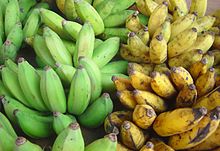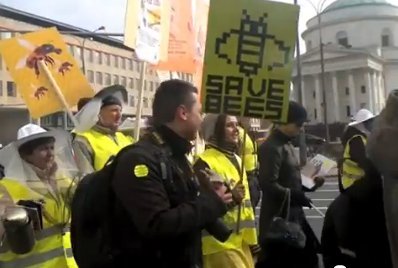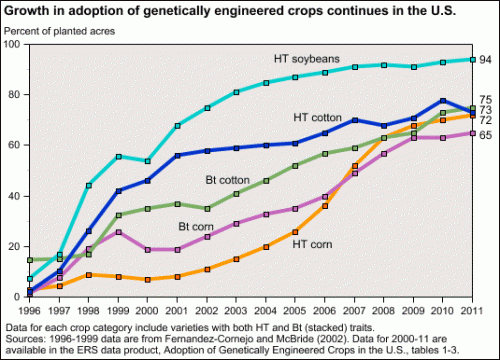Please post and distribute
More GM Crops in Puerto Rico, Why We Should Worry
Carmelo Ruiz-Marrero
Puerto Rico Project on Biosafety
September 12 2011
The US-based Monsanto company, the world's biggest seed company and undisputed world leader in agricultural biotechnology, announced in June 2011 that it would increase its activities in Puerto Rico. Specifically, the corporation is investing $4.3 million in the construction of a 20,000-square foot laboratory for corn and cotton seed development in the southern municipality of Juana Diaz. These will be genetically modified (GM) seeds, no doubt, since Monsanto spends the bulk of its research and development budget on this technology. The announcement was made in Washington DC during the Biotechnology Industry Organization's annual conference. Puerto Rico Industrial Development Corporation executive director Jose Perez-Riera and agriculture secretary Javier Rivera-Aquino were in the convention in a celebration mood with Juan Santiago, Monsanto's chief of operations in Puerto Rico, while he was making the announcement.
Pioneer Hi Bred, Monsanto's leading competitor in the GM seed business, is not far behind. That same month it inaugurated in the municipality of Salinas, several miles east of Juana Diaz, a 22,000-square foot seed laboratory. Pioneer, which has been in Puerto Rico since 1989, has been a subsidiary of multinational corporation Dupont since 1999. The Dupont-Pioneer corporate giant was the world's largest seed company until 2005, when Monsanto surpassed it by purchasing Mexico's Seminis seed company for $1.4 billion.
Puerto Rico governor Luis Fortuño attended the Pioneer laboratory's festive inauguration and heaped praise on the agricultural biotechnology corporations that operate in the island. “Puerto Rico is an ideal place for bioagricultural research,” Fortuño said during the inauguration. “The island boasts a regulatory framework aligned with the U.S., an efficient transportation system, a longer growing season suitable for planting crops year-round, novel economic incentives, and a highly-educated workforce.”.
What's wrong with all this? GM products are the subject of a worldwide heated controversy, whose participants include doctors and scientists as well as peasant movements, international organizations and political leaders, and has led to arrests, violent repression and persecution against scientists that have dared to contradict the official discourse on biotechnology. Since the 1990's this debate has produced numerous books, television and newspaper reports, documentaries (both short and of full-length), scientific symposia, contentious international negotiations, and even protest marches and civil disobedience.
When we say genetically modified we mean an organism whose genetic code, or genome, has had foreign genes inserted into it through genetic engineering. The process of genetic engineering tears down cell barriers in order to make genetic combinations that would have never happened in nature, and it's used in food and agriculture since the 1990's. There are actually tens of millions of hectares of farmland planted with GM crops in the world, the great majority of them in only four countries: the United States, Canada, Brazil and Argentina. Almost all these GM crops are soy and corn. The rest are mostly cotton and canola.
These GM crops do not yield more than their conventional non-GM counterparts, they are not more nutritional, and do not use less toxic agrochemicals. The majority were altered to be immune to a herbicide called Roundup, a product of Monsanto, and they are thus known as Roundup Ready. The rest produce their own pesticide, and are known as Bt crops. This soy and corn are used to make, among other things, flour, starch, cooking oil, high fructose corn syrup, biofuels and feed for the farm animals that give us meat, eggs and dairy.
A safe herbicide?
It goes without saying that foodstuffs derived from Roundup Ready crops can have substantial traces of Roundup. So, how safe is this herbicide for human consumption?
In June 2011 an international group of scientists and researchers, organized as Earth Open Source, published a report titled “Roundup and Birth Defects: Is the Public Being Kept in the Dark?”. The document says that as early as the 1980's Monsanto knew that glyphosate, active ingredient of Roundup, caused birth defects in laboratory animals; that the German government had this information at least since 1998; and, to quote from the report's press release:
“The German government has known about these findings since at least the 1990s, when as the 'rapporteur' member state (of the European Union) for glyphosate, it reviewed industry's studies for the EU approval of the herbicide. The European Commission has known since at least 2002, when it signed off on glyphosate's approval. But this information was not made public. On the contrary, regulators have consistently misled the public about glyphosate's safety. As recently as last year, the German Federal Office for Consumer Protection and Food Safety, BVL, told the Commission there was "no evidence of 'teratogenicity' (ability to cause birth defects) for glyphosate.” (Parentheses in original)
In 2010 a prestigious scientific journal, Chemical Research in Toxicology, published a peer-reviewed study, written by Argentine embryologist Andres Carrasco, leading researcher at the National Council of Scientific and Technical Research (Conicet) and director of the molecular embryology laboratory at the University of Buenos Aires, which determined that glyphosate is extremely toxic for amphibian embryos in doses much lower than those used in agriculturural sprayings, as much as 1,540 times lower. And Argentina has over 20 million hectares (over half of the country's farmland) planted with Roundup Ready soy, which receive over 200 million liters of glyphosate a year!
In August 2010 Argentina held its First National Encounter of Medics of Fumigated Towns, in which participating scientists, researchers, and academics wrote an open letter to agribusiness trade associations, from which we quote:
“The cancers and other severe illnesses are detected with more frequency now. As well as miscarriages, disruptions of fertility and the birth of children with birth malformations, which we find in very elevated rates. And respiratory, endocrine, hematological, neurological and psychic ailments are, also now, much more frequent in the systematically fumigated populations. Fumigated because they share the same geographic space as the agroindustrial and genetically engineered crops that you yourselves exploit.
... We, the doctors and other members of the health teams, the researchers, scientists and academics that analyze this problem, are certain that the increasing health ailments in the inhabitants of the fumigated towns are caused by the fumigations that you yourselves carry out.”
The Grupo de Reflexion Rural (GRR), an Argentine NGO that is critical of GM crops and industrial agriculture, has been documenting these horrors for years:
“Some time ago, the (GRR) took on the task of collecting information about the impacts of glyphosate on diverse Argentine populations: among other places, in the Ituzaingo neighborhood in Cordoba; Las Petacas, in Santa Fe; in San Lorenzo, also in Santa Fe; and Los Toldos in Buenos Aires. In each of these populations dramatic situations were detected. And precisely in the Ituzaingo neighborhood... over two hundred cancer cases in a population of hardly 5,000 inhabitants, as well as deformations among the newborn. Ituzaingo is a population surrounded by soy fields that are systematically fumigated. The spray from these fumigations arrives at the doors of the houses.”
In 2008 Chemical Research in Toxicology published a study by Gilles-Eric Seralini, a French specialist in molecular biology and professor at the University of Caen, which indicates that Roundup is lethal to human cells. According to Seralini's research, doses far below those used on soy crops cause cell death in a few hours. “Even in doses diluted one thousand times, Roundup herbicide stimulates the deaths of human embryonic cells, which could cause deformations, miscarriages, hormonal, genital and reproductive problems, as well as different types of cancer”, Seralini told Argentine newspaper Pagina 12.
In 2005 Seralini had already confirmed that Roundup provokes toxic effects in human placental cells and embryos even in very low doses, in a study published by Environmental Health Perspectives. The herbicide kills a great proportion of these cells after only 18 hours of exposure in concentrations lower than those of agricultural use.
“He also emphasized that in solutions of between 10 thousand and 100 thousand times more diluted than in the commercial product it no longer killed cells, but it blocked their production of sex hormones, which could provoke in fetuses difficulties in the development of bones and of the reproductive system. He alerted about the possibility that the herbicide could be an endocrine disruptor, and called for new studies.”
Seralini's study in Chemical Research in Toxicology focused on human umbilical cord, embryo and placental cells. The cells died in the 24 hours of exposure to the Roundup varieties. “A cell action mechanism was studied with four different Roundup formulations (Express, Bioforce or Extra, Gran Tavaraux, and Grand Tavaraux Plus). The results show that the four Roundup herbicides, and the pure glyphosate, cause cell death. Confirmed by the morphology of the cells after the treatment it is determined that, even in the lowest of concentrations, it causes important cell death”, says the publication.
Genetically engineered pesticide
Biotechnology companies assure us that the toxin secreted by Bt crops is harmless to human beings and that it dissolves in the human digestive system. Today we know both statements are wrong.
Bt toxin was found in the blood of pregnant women and their fetuses, as well as in non-pregnant women, by doctors at Sherbrooke University Hospital in Quebec. Specifically, the study determined that the toxin was present in 93% of 30 pregnant women, in the umbilical cord blood of 80% of the fetuses, and in 67% of 39 non-pregnant women. The study has been accepted for publication in Reproductive Toxicology, a peer-reviewed journal.
Research funded by the Italian government published in 2008 found that laboratory rats fed with Monsanto's Bt corn had abnormally high IgE and IgG antibodies, something that is typically associated with allergies and infections. They also had elevated levels of interleukins, which is associated to various diseases in humans, from rheumatoid arthritis and osteoporosis to multiple sclerosis and Lou Gehrig's. The animals also had abnormally high levels of T gamma delta cells, which is what happens in cases of asthma, childhood food allergies, and juvenile arthritis.
The insecticide produced by the tissues of Bt plants is the genetically engineered version of a natural toxin produced by Bacillus thuringiensis, a very common soil bacterium. Natural Bt has been used as pesticide in organic agriculture for decades. Biotech companies assure that this pesticide in its natural form is safe and that therefore its GM variant must be safe too. But today we know that natural Bt can have adverse effects if it is not used correctly.
According to scientific peer-reviewed studies (Vazquez et al), lab rats fed with natural Bt toxin suffered tissue damage and developed immune responses as severe as those caused by cholera toxin, and even started having adverse reactions to foods that previously had caused them no trouble.
Adverse reactions in humans have alse been documented:
In 1999 Environmental Health Perspectives published a study authored by I. L. Bernstein et al, which found that farm workers have developed immune system reactions when exposed to natural Bt.
In March 2001 the Environmental Protection Agency's Scientific Advisory Panel warned that published studies on animals and humans suggest that Bt proteins can cause allergies. The EPA ignored the panel, and it also ignored a 1993 Washington State Health Department report and a study published by the American Journal of Public Health in 1990 which documented that hundreds of people in the states of Washington and Oregon had allergy symptoms after Bt sprayings to eradicate the gypsy moth.
In India there are thousands of farm workers that have symptoms similar to the aforementioned cases reported in the USA- what these Indian farm workers all have in common is that they work with Bt cotton plants. "According to reports and records from doctors, hospitals, and pharmacies, as well as numerous investigative reports and case studies, workers are struggling with constant itching and rashes; some take antihistamines every day in order to go to work.", according to researcher Jeffrey Smith, executive director of the Institute for Responsible Technology and author of "Seeds of Deception".
We quote Smith again:
"When they allow livestock to graze on the Bt cotton plants after harvest, thousands of sheep, goats, and buffalo died. Numerous others got sick. I visited one village where for seven to eight years they allowed their buffalo to graze on natural cotton plants without incident. But on January 3rd, 2008, they allowed their 13 buffalo to graze on Bt cotton plants for the first time. After just one day’s exposure, all died. The village also lost 26 goats and sheep. One small study in Andhra Pradesh reported that all six sheep that grazed on Bt cotton plants died within a month, while the three controls fed natural cotton plants showed no adverse symptoms."
Information on the hazards of Bt crops is not new. On May 22 2005, England's The Independent reported the existence of a secret Monsanto report about Mon 863, one of their Bt corn varieties. According to the 1,139-page report, rats fed with this corn for 13 weeks had unusually high counts of white blood cells and lymphocytes, which increase in cases of cancer, poisoning or infection; low levels of reticulocytes, which can indicate anemia; loss of kidney weight, which can indicate blood pressure problems; liver necrosis; high blood sugar; and other adverse symptoms. Monsanto spokespeople assured that the company would make the report public, but did not do so willingly, invoking "confidentiality", and at first only published an 11-page summary. It was not until a German court ordered its disclosure months later that the full text became public.
It is important to point out that this important information about Mon 863 is public not because of Monsanto's good faith but because someone, most probably an employee with access to the company's confidential documents took the risk of taking it to the press. If it were not for this anonymous hero, this Wikileaks of biotechnology, today we would be blissfully ignorant of the effects of this genetically engineered corn. We must ask then, Can there be other harmful GM foods that the biotech industry is feeding us knowing full well that they can cause harm to people?
This has been an extremely brief summary of health risks caused by the GM products that companies like Monsanto and Dupont are developing in Puerto Rican farmlands. For more information, please see the bilingual blog of the Puerto Rico Project on Biosafety (
http://bioseguridad.blogspot.com/), a small collective founded in 2004 to alert the citizenry about the implications of GM crops and products.
A Spanish language version of this article was published in 80 Grados, a Puerto Rican online publication (http://www.80grados.net/).
Ruiz-Marrero is a Puerto Rican author, investigative journalist, environmental educator, and director of the Project on Biosafety. He is a Research Associate of the Institute for Social Ecology and a Fellow of the Oakland Institute, and has published over 1,000 articles over the last 20 years in the most diverse outlets, including Counterpunch, Inter Press Service, Corporate Watch, Alternet, Grist, Z Magazine, CIP Americas Policy Program, Food First, Earth Island Journal, and many more. His bilingual blog on all things progressive and ecological is updated almost daily (http://carmeloruiz.blogspot.com/). His Twitter ID is carmeloruiz.
SOURCES:
FOR FURTHER REFERENCE:
Etiquetas: Carmelo, en, Puerto Rico


 At
the Group of Eight (G8) meetings this past weekend at Camp David,
President Obama and the leaders of the rest of the world's richest
nations abandoned their governments' previous commitments to donate
$7.3 billion a year to end hunger in Africa and instead left the problem
in the hands of the so-called New Alliance for Food Security and
Nutrition where private corporations will invest $3 billion over 10
years - Monsanto has committed $50 million - beginning in three
countries, Tanzania, Ghana and Ethiopia.
At
the Group of Eight (G8) meetings this past weekend at Camp David,
President Obama and the leaders of the rest of the world's richest
nations abandoned their governments' previous commitments to donate
$7.3 billion a year to end hunger in Africa and instead left the problem
in the hands of the so-called New Alliance for Food Security and
Nutrition where private corporations will invest $3 billion over 10
years - Monsanto has committed $50 million - beginning in three
countries, Tanzania, Ghana and Ethiopia. 


 In
an effort to expose Monsanto's greed and hold the company accountable
for their crimes, we are making Genetic Crimes Unit (GCU) Action Kits
available for free to the first 50 groups who commit to Occupy Monsanto
during the week of September 17th, 2012. Fill out the online form with
your mailing address, email address, size, and basic info (date, time,
and location) about your Occupy Monsanto plans for the week of September
17th and get your free kit!
In
an effort to expose Monsanto's greed and hold the company accountable
for their crimes, we are making Genetic Crimes Unit (GCU) Action Kits
available for free to the first 50 groups who commit to Occupy Monsanto
during the week of September 17th, 2012. Fill out the online form with
your mailing address, email address, size, and basic info (date, time,
and location) about your Occupy Monsanto plans for the week of September
17th and get your free kit! 




